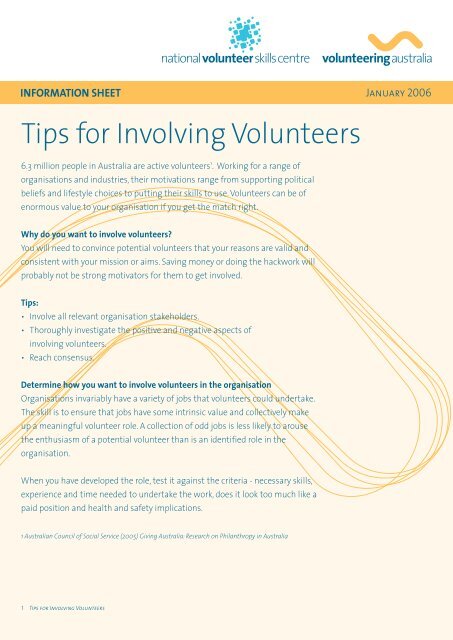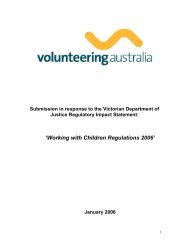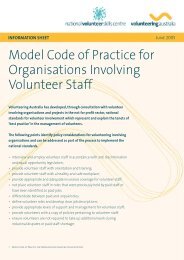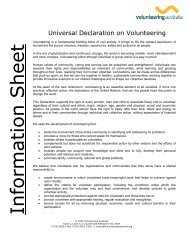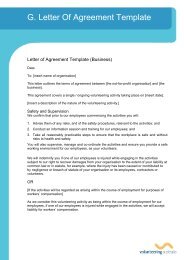Tips for Involving Volunteers - Volunteering Australia
Tips for Involving Volunteers - Volunteering Australia
Tips for Involving Volunteers - Volunteering Australia
You also want an ePaper? Increase the reach of your titles
YUMPU automatically turns print PDFs into web optimized ePapers that Google loves.
Can you af<strong>for</strong>d to involve volunteers?Identify the costs to your organisation. Volunteer work conditions and thenature of the work will greatly influence the volunteer program budget. Staffsupervision, travel allowances, out of pocket expenses, rent, additionalequipment, insurance and utilities are elements to include in your budget.<strong>Tips</strong>:• Establish a small team to examine the feasibility of involving volunteers.• Develop a budget.• Research and consider funding options.Decide who will supervise, support and manage the volunteer programThe best way of ensuring that volunteers remain keen and committed to theorganisation is to appoint a manager, coordinator or team leader responsible <strong>for</strong>their management. Through this position it is possible to monitor the volunteerprogram and make adjustments as necessary.Some organisations can af<strong>for</strong>d to employ a manager of volunteers while othersrely on existing staff members to incorporate volunteer coordination into anexisting role. For small organisations neither is possible. These need to identifyother models to coordinate the volunteer program, such as collective decisionmaking or a structured program with a volunteer team leader.Regardless of the model you choose your appointed leader needs the support ofthe organisation to undertake the work. This leadership position is pivotal to thesuccess of the program - the volunteer management style, opportunity toparticipate in organisational decisions, level of consultation and recognition oftheir work, are the critical success factors to the volunteer. It is against thesecriteria that the organisation will be judged by the volunteer and against whichthey make a decision to stay.2 <strong>Tips</strong> <strong>for</strong> <strong>Involving</strong> <strong>Volunteers</strong>
<strong>Tips</strong>:• Choose your management model carefully.• Support the position.• Give the position some authority.• Formalise ways in which volunteers are involved in decisions, consultedand recognised.Develop policy to guide the involvement of volunteers in the organisationWell researched and articulated policy is the most useful tool <strong>for</strong> anyorganisation wishing to involve volunteers. Although time consuming todevelop, it is a necessary framework <strong>for</strong> involving volunteers. Policy does nothave to be a lengthy document but it should contain enough detail to protectthe volunteer and the organisation.The policy development process is critical to its success and should reflect theagreed policy of the organisation. Suggested elements <strong>for</strong> volunteer policy are:• statements on how volunteers are to be managed;• conditions of their employment;• statements ensuring the rights of volunteers;• travel allowance;• reimbursements <strong>for</strong> out of pocket expenses;• occupational health and safety conditions;• insurance coverage;• equal opportunity, grievance and disciplinary policy;• training requirements or commitments;• support and supervision; and• personal details and privacy, security and confidentiality.<strong>Tips</strong>:• Include all internal stakeholders in the development of the policy• Get agreement around the policy statements• Write the policy in reader friendly language• Ensure that it is available and accessible.3 <strong>Tips</strong> <strong>for</strong> <strong>Involving</strong> <strong>Volunteers</strong>
Prepare your organisation <strong>for</strong> volunteer involvementOnce your organisation is ready to make both the financial and policycommitment to volunteers, planning must begin <strong>for</strong> their recruitment. This willinvolve drafting job descriptions, developing a budget, organising insurance andplanning the recruitment campaign.You also need to operationalise all the policy statements you agonised over. Ifyou are intending to reimburse travel, <strong>for</strong> example, you will need an expense<strong>for</strong>m. If you made statements about grievance and disciplinary action, you willneed to develop the procedures and supporting paper work.If you employ paid staff in the organisation, you may already have many of theprocedures documented and the required <strong>for</strong>ms. Many organisations take thisopportunity to get all of their human resources material updated and into a<strong>for</strong>mat that can be used by all staff, paid and unpaid alike. If you are a new orsmall volunteer group this work can be done by a working party and need notbe sophisticated, just thought through. There are many organisations aroundwho can help you discover the wheel.<strong>Tips</strong>:• Streamline and simplify procedures Include all internal stakeholders in thedevelopment of the policy.• Use the same procedures <strong>for</strong> paid and volunteer staff wherever possible.Get agreement around the policy statements.• Produce materials in an accessible <strong>for</strong>mat.Write the policy in readerfriendly language.• If you are a small or new volunteer group cover the basics first.• Ask your local volunteer centre <strong>for</strong> help.4 <strong>Tips</strong> <strong>for</strong> <strong>Involving</strong> <strong>Volunteers</strong>
Writing the job descriptionVolunteer job descriptions need the same level of detail as paid job descriptionsand most organisations use similar <strong>for</strong>mats <strong>for</strong> both. If however, you are settingup a new program and do not have paid workers or job descriptions, here aresome things you could include:• enough detail <strong>for</strong> the new volunteer to understand what the job is, withoutoverwhelming them with a task list that leaves little room <strong>for</strong> innovationor creativity;• the hours/days required; and• the lines of accountability and the objectives of the positionThe job description is an important document. It guides the expectations of thevolunteer and the organisation, and serves as the protection <strong>for</strong> both in itsoutline of the agreed position activities.<strong>Tips</strong>:• Make the job description snappy• Leave room <strong>for</strong> negotiation.• Build in evaluation of the position.Planning <strong>for</strong> the interviewsInterviewing <strong>for</strong> volunteers involves identifying the skills you require anddeveloping selection criteria. This is your opportunity to match applicants to thevolunteer positions.Important considerations include where and who you will interview and howyou will notify successful and unsuccessful applicants. Good communication isparamount to this process. Be clear in your objectives and knowledgeable of theselection criteria.5 <strong>Tips</strong> <strong>for</strong> <strong>Involving</strong> <strong>Volunteers</strong>
<strong>Tips</strong>:• Plan the interview and questions.• Develop the selection criteria..• Decide on key questions.• Identify the kind of answers you want.• Use an interview panel.• Stick to the questions.• Keep notes on each interview.• Get back to applicants when promised.Recruitment of volunteer staffOrganisations use many kinds of volunteer recruitment, ranging from personalcontact through to a large media campaign. Obviously the method <strong>for</strong>recruiting large numbers of people <strong>for</strong> a one-off event is going to be different tothe method used to recruit a small number of permanent volunteer staff.A one-off campaign may use the mass media, radio and newspapers. Recruiting<strong>for</strong> a small number of volunteers however, may involve personal contact,advertising the specific role in papers or magazines, or using flyers at events.Certain principles remain constant throughout a recruitment campaign - keepthe message simple, use several mediums, make the campaign professional andbe prepared <strong>for</strong> the result. ABS statistics show that most volunteers have beenpersonally asked to join the organisation they work <strong>for</strong> and this still appears tobe the most successful way of attracting people.<strong>Tips</strong>:• Brainstorm the campaign• Use your personal networks• Plan <strong>for</strong> at least three discrete messages to reach your target audience• Work out where the people you want to reach are, what they read andwhat they do.• Recruit <strong>for</strong> specific job types.6 <strong>Tips</strong> <strong>for</strong> <strong>Involving</strong> <strong>Volunteers</strong>
Orientation of new volunteer staffOrientation is very important to new staff - it indicates how the organisationwill treat its volunteers now and in the future. Disorganisation at this earlystage may negatively influence a volunteer’s perception of the organisation<strong>for</strong>ever.<strong>Tips</strong>:• Develop an orientation check list.• Use it!Training <strong>for</strong> new volunteersThe challenge <strong>for</strong> training is to make it desirable and relevant. Using internalfacilitators or external training providers, your organisation will benefit fromhaving training as part of the volunteer staff’s contractual arrangement.<strong>Tips</strong>:• Plan <strong>for</strong> training• Develop an orientation check list.• Use training as an introduction to the organisation.• Make training obligatory if the position demands training.• Make training desirable by keeping it interesting and relevant.
Final stepFirst impressions count. What will prospective volunteers feel when they firstcome into contact with your organisation? Ask yourselves questions like:• Is our message clear?• Are we all in agreement about involving volunteers?• Have we got in<strong>for</strong>mation about the organisation prepared to send out inresponse to enquiries• Are the people answering the phones briefed well enough to field questionsor refer correctly?• Do we look as if we know what we are doing?• Can we predict some of the questions potential volunteers may ask be<strong>for</strong>e orduring the interview and prepare answers <strong>for</strong> them?• Do our systems ensure that potential volunteers feel confident theirin<strong>for</strong>mation will not be lost?• Will volunteers feel they are being treated seriously and with respect?• Do we have strategies to ensure the process does not humiliate volunteerswho are not invited to join the organisation?• Can we ensure that volunteer hours are acknowledged and important tothe organisation?• Are the volunteer roles constructed to protect the volunteer from exploitationwhile using their skill to the maximum?• Have we agreement that volunteers are part of the organisation andthere<strong>for</strong>e included in decisions, consulted, briefed and supported intheir work?<strong>Tips</strong>:• In <strong>Australia</strong> there are volunteer centres in every capital city and many regionalareas. All the centres have libraries and enthusiastic, knowledgeable staff whocan provide you with extra support and in<strong>for</strong>mation if you need it. Check ourcontact list <strong>for</strong> the centre nearest to you.<strong>Volunteering</strong> <strong>Australia</strong> Inc.Suite 2, Level 311 Queens RoadMelbourne Victoria 304<strong>Australia</strong>P: +61 (0)3 9820 4100F: +61 (0)3 9820 1206E: volaus@volunteerngaustralia.orgW: www.volunteeringaustralia.org8 <strong>Tips</strong> <strong>for</strong> <strong>Involving</strong> <strong>Volunteers</strong>ARBN: 062 806 464


